Respiratory Protective Equipment (RPE)
Respiratory Protective Equipment (RPE) is a type of Personal Protective Equipment (PPE) used to protect the individual wearer against the inhalation of hazardous substances in the workplace air.
On this page
- What is Respiratory Protective Equipment (RPE)
- Using RPE
- Types of RPE
- What is a Face Fit test?
- Arranging a Face Fit test
- Surgical masks and face coverings
What is Respiratory Protective Equipment (RPE)
There are two main types of RPE:
- Facepieces are an example of negative pressure RPE (i.e. pulling in air through the filter), can be referred to as respirators, commonly used in laboratories and building work
- Breathing apparatus is an example of positive pressure RPE (i.e. pushing the air to the wearer or into the filter), commonly used by firefighters
Both types of RPE can be either a full facepiece or a half facepiece just covering the wearer's nose and mouth.
Half facepieces are the most commonly used at UCL.
RPE should only be used where adequate control of exposure cannot be achieved by other means. In other words, as a last resort within the hierarchy of control measures: Elimination, Transfer of risk, Isolating/Engineered, Safe working systems or practices and PPE.
> Read more about the Hierarchy of Control Measures
RPE protects the wearer from harmful substances contaminating the air in the form of dust, mist, gas or fume. For example:
- Cutting a material such as stone, concrete or wood
- Using a liquid containing volatile solvents
- Handling a dusty powder
Or where oxygen levels are low. For example:
- Confined spaces, such as a chamber or tank
- Areas where animal allergens are present
The above lists are for illustration and are not exhaustive.
Using RPE
RPE should:
- Be adequate for the hazard - it should reduce exposure to the level required to protect the wearer’s health
- Be suitable for the wearer, task and environment - the wearer should be able to work freely and the RPE should be compatible with any other PPE worn and should not produce any additional risks:
- Be appropriate for its use.
Activities which require the wearer to use tight fitting RPE must use RPE that provides an appropriate seal. Note that this seal cannot be achieved with a respirator/mask relying solely on ear loops, clips or snuggers to hold it in place. HSE research has shown that an adequate seal is not provided even if an ear loop respirator has a CE mark or UKCA mark. (This does not apply to surgical masks or face coverings as they are used for a different purpose and are not required to be tight fitting)
> Read more about HSE recommendations on tight fitting RPE
Before using RPE, you should assess:
- The hazardous substance and the amount in the air (exposure)
- The form of the substance in the air (e.g. gas, particle, vapour)
- The type of work being carried out
- Specific wearer requirements, such as other PPE or a need for spectacles
- The type of RPE being used to ensure it is suitable for the activity
Negative pressure RPE must not be used in oxygen-deficient atmospheres. You will require suitable breathing apparatus (positive pressure RPE) and should seek professional advice in selecting the correct RPE.
For more information please contact Safety Services.
> Read more about risk assessments
Types of RPE
If you have identified that tight fitting RPE is required, you should note HSE does not recommend using a mask/respirator which relies solely on ear loops to hold it in place (even if it has a CE mark/UKCA mark).
FFP2 and FFP3 facepieces
- The technical term for these facepieces is RPE – Respiratory Protective Equipment
- FFP stands for Filtering Facepiece Particulate
- FFP3 is the highest level of filtration for a Filtering Facepiece Particulate
- FFP3 masks are also used in many industrial and work-related processes to protect against high hazard dust and particulates, silica, wood etc
- A successful Face Fit test is required before a FFP2 and FFP3 facepiece can be used
Disposable respirators (facepieces)
- Most types of negative pressure RPE can be disposable. Disposable means that the respirator can only be used for one set use. This depends on the task and could be one session, one day or one week. The risk assessment will state how often you have to change your disposable respirator
- Disposable respirators are only effective when there is a good seal between the edges of the respirator and the wearer's face. If the seal is poor, protection will be compromised as contaminated air can leak in through any gaps
- A successful Face Fit test is required before using a disposable respirator to ensure a good fit
- Multiple uses of the disposable respirator, repeatedly taking it one and off, will affect the fit eventually making it unsafe. It is important that disposable respirators are used in accordance with the risk assessment
Disposable facepieces used at UCL
Six commonly available types of disposable facepieces are used at UCL as well as alternatives for those who cannot have a successful qualitative Face Fit test on these facepieces.
3M K102 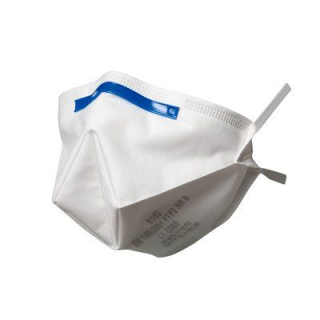 | 3M VFlex 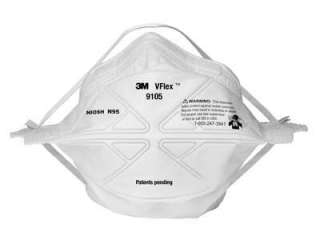 | 3M 9322 FFP2 blue straps 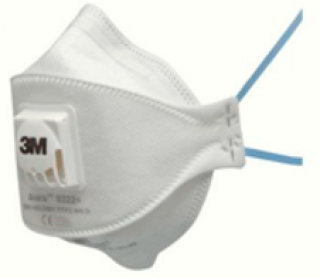 |
3M 9332 FFP3 red straps 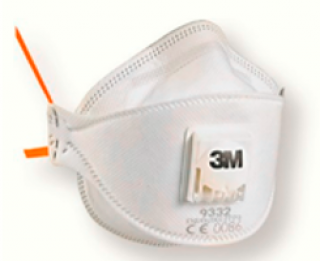 | 3M 8835 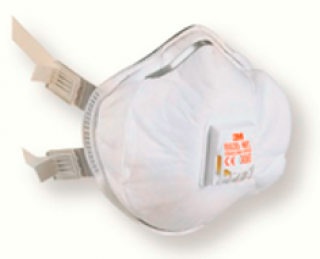 | Alpha Solway Alpha S 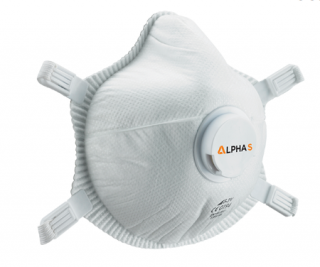 |
What is a Face Fit test?
Negative pressure facepieces rely on having a good seal with the wearer’s face. To ensure the facepiece or mask is suitable for the wearer, a Face Fit test should be carried out when the RPE is selected. An inadequate fit can lead to leaks. Leaks reduce the protection provided and lead to immediate or long-term ill-health or can even put the RPE wearer’s life in danger.
If you wear more than one type of tight-fitting facepiece/mask, then each type of facepiece should be fit tested.
It is the responsibility of line managers/supervisors to ensure that the make, model, type and size of facepiece that the wearer wore when they had their successful fit test is made available for their use.
A face fit test must be repeated whenever there is a change to the RPE type, size, model or material or whenever there is a change to the circumstances that could alter the fit of the RPE. For example:
- Weight loss or gain
- Substantial dental work
- Any facial changes (scars, moles, effects of ageing etc) around the facial hair area
- Facial piercings
- Introduction or change in other head-worn personal protective equipment (PPE)
There is no stipulated frequency for re-testing but it is advised to do this every 3 years or if this is a significant change in circumstances.
> What to expect when having a Face Fit test
Arranging a Face Fit test
UCL Departments are required to identify their trained and experienced departmental face fit testers and record them in the riskNET Departmental Responsible Persons Register. Contact your department's face fit tester for an appointment.
> riskNET (UCL Login required)
Surgical masks and face coverings
Surgical masks and face coverings are worn on the face but they are designed to protect others around the user, rather than the user themselves.
Surgical masks
- Surgical masks are designed to protect the patient from the wearers’ breath being expelled
- Surgical masks are required to meet set standards regarding infection control and suitability for work in a medical environment
- A Face Fit test is not required for surgical masks
Face coverings
- Like surgical masks, face coverings are designed to protect others rather than the wearer
- Unlike surgical masks, there are no standards they need to meet however UCL has guidance on what is best practice for face covering
- A Face Fit test is not required for face coverings
Last updated: Monday, May 16, 2022
 Close
Close


